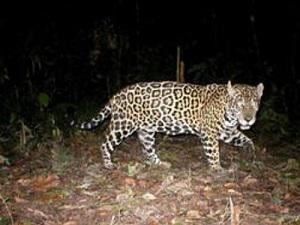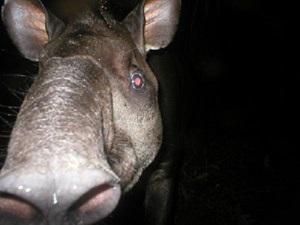Malini Pittet
The aim of the project is to develop a methodology for the long term monitoring of species using camera traps and line transects with a special focus on felines and their adaptation to water level fluctuations.

Sub adult male jaguar.
The Pacaya-Samiria National Reserve is the largest protected area in Peru spread over 20’789 km² in the North-Western part of the country. It is a physically influenced rainforest being seasonally flooded as a result of ocean currents affecting the Pacific coast and rainfall events in the Andes.

A Curious adult male Brazilian tapir.
Monitoring of population is particularly challenging in view of the virgin and dense vegetation of this park. Till date very few attempts were made at deploying camera traps in this national park. It is necessary to develop a multiple methodology strategy for the long term monitoring of species to have an overview of populations in “normal conditions” and be compared to populations in “abnormal conditions”. By providing a baseline “indicator” status of the assemblage and densities, populations in trouble can be detected and strategies to protect the vulnerable ones can be designed.
The combination of camera-trapping and line transects provides a 24 hour insight of terrestrial, arboreal, nocturnal and diurnal populations. Individual species information as well as population assemblages based on habitats can be determined. Forty camera traps will be deployed in a non random pattern for approximately 20 to 25 days per study block, covering various sections of the Samiria River. The duration of the study will allow the traps to record distribution and abundance of species during the dry and flooded season. The information collected from photographic evidence and line transects will be compared and analysed to determine the general movements of wildlife in the area and their response to the physical changes in their habitat.
The current study will be focused on the population, distribution and behaviour of jaguars with an additional focus on pumas and ocelots to set up a reliable, systematic methodology for the monitoring of these species. Another major outcome of this project will be a methodology, combining camera traps and transects, for long term population monitoring specifically designed for landscapes such as prevailing in Pacaya Samiria. Other significant outcomes will be the direct exposure and training of at least one Peruvian biologist and two guides / trackers as well as park guards to the methodology.